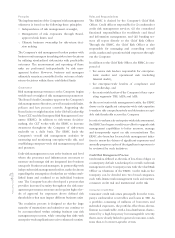American Express 2004 Annual Report Download - page 37
Download and view the complete annual report
Please find page 37 of the 2004 American Express annual report below. You can navigate through the pages in the report by either clicking on the pages listed below, or by using the keyword search tool below to find specific information within the annual report.
on underlying investments as of December 31, 2004.
The level of change in near-term default rates would
have to be significantly higher than 100 basis points to
cause a change in carrying value of the Company’s
structured investments due to previously recognized
impairment losses coupled with subsequent improve-
ment in actual default rates.
See Recently Issued Accounting Standards section of
Note 1 to the Consolidated Financial Statements for a
discussion of Emerging Issues Task Force (EITF) Issue
03-1, “The Meaning of Other-Than-Temporary Impair-
ment and Its Application to Certain Investments,”
which, when finalized by the FASB, may affect the
Company’s investment securities valuation policy.
Deferred acquisition costs
Deferred acquisition costs (DAC) represent the costs of
acquiring new insurance, annuity and mutual fund busi-
ness, principally direct sales commissions and other dis-
tribution and underwriting costs that have been deferred
on the sale of annuity, life and health insurance and, to
a lesser extent, property/casualty and certain mutual
fund products. These costs are deferred to the extent
they are recoverable from future profits. For annuity and
insurance products, DAC are amortized over periods
approximating the lives of the business, principally as a
percentage of premiums or estimated gross profits asso-
ciated with the products depending on the product’s
characteristics. For certain mutual fund products, DAC
are generally amortized over fixed periods on a straight-
line basis.
For annuity and life and health insurance products, the
DAC balances at any reporting date are supported by
projections that show management expects there to be
adequate premiums, estimated gross profits or interest
margins after that date to amortize the remaining DAC
balances. These projections are inherently uncertain
because they require management to make assumptions
about financial markets, anticipated mortality and mor-
bidity levels, and policyholder behavior over periods
extending well into the future. Projection periods used
for AEFA’s annuity products are typically 10 to 25 years,
while projection periods for AEFA’s life and health insur-
ance products are often 50 years or longer. Management
regularly monitors financial market conditions and
actual policyholder behavior experience and compares
them to its assumptions. For annuity and universal life
insurance products, the assumptions made in projecting
future results and calculating the DAC balance and DAC
amortization expense are management’s best estimates.
Management is required to update these assumptions
whenever it appears that, based on actual experience or
other evidence, earlier estimates should be revised.
When assumptions are changed, the percentage of esti-
mated gross profits or portion of interest margins used
to amortize DAC might also change. A change in the
required amortization percentage is applied retrospec-
tively; an increase in amortization percentage will result
in a decrease in DAC balance and an increase in DAC
amortization expense while a decrease in amortization
percentage will result in an increase in DAC balance and
a decrease in DAC amortization expense.
The impact on results of operations of changing
assumptions can be either positive or negative in any
particular period and is reflected in the period in which
such changes are made.
For other life and health insurance products, the
assumptions made in calculating the DAC balance and
DAC amortization expense are intended to provide for
adverse deviations in experience and are revised only
if management concludes experience will be so
adverse that DAC is not recoverable. If management
concludes that DAC is not recoverable, DAC is reduced
to the amount that is recoverable based on best esti-
mate assumptions.
For annuity and life and health insurance products, key
assumptions underlying these long-term projections
include interest rates (both earning rates on invested
assets and rates credited to policyholder accounts),
equity market performance, mortality and morbidity
rates and the rates at which policyholders are expected
to surrender their contracts, make withdrawals from
their contracts and make additional deposits to their
contracts. Assumptions about interest rates drive pro-
jected interest margins, while assumptions about rates
credited to policyholder accounts and equity market
performance drive projected customer asset value
growth rates, and assumptions about surrenders, with-
drawals and deposits comprise projected persistency
rates. Management must also make assumptions to
project maintenance expenses associated with servic-
ing its annuity and insurance business during the DAC
amortization period.
The customer asset value growth rate is the rate at
which contract values are assumed to appreciate in the
future. The rate is net of asset fees and anticipates a
blend of equity and fixed income investments. Man-
agement reviews and, where appropriate, adjusts its
assumptions with respect to customer asset value
growth rates on a quarterly basis. The Company uses
a mean reversion method as a monthly guideline in
AXP
AR.04
35
Financial Review
























